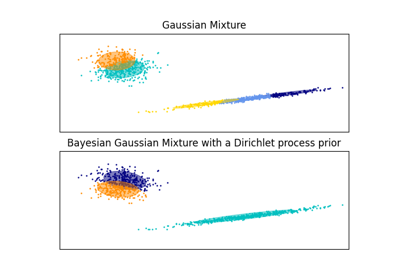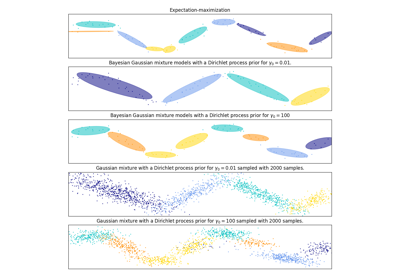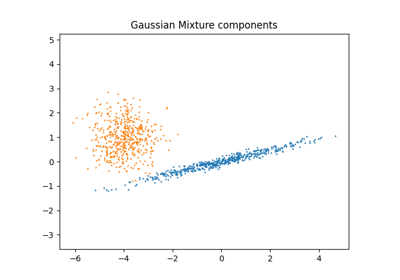Note
Go to the end to download the full example code. or to run this example in your browser via Binder
GMM 协方差#
高斯混合模型的几种协方差类型的演示。
有关估计器的更多信息,请参见 高斯混合模型 。
尽管 GMM 通常用于聚类,但我们可以将获得的聚类与数据集中的实际类别进行比较。我们用训练集中类别的均值初始化高斯分布的均值,以使这种比较有效。
我们使用鸢尾花数据集上的各种 GMM 协方差类型绘制训练数据和保留的测试数据上的预测标签。我们按性能递增顺序比较具有球形、对角线、完整和绑定协方差矩阵的 GMM。尽管一般来说完整协方差的表现最好,但它容易在小数据集上过拟合,并且不能很好地泛化到保留的测试数据。
在图中,训练数据显示为点,而测试数据显示为叉。鸢尾花数据集是四维的。这里只显示前两个维度,因此某些点在其他维度上是分开的。

# 作者:scikit-learn 开发者
# SPDX-License-Identifier: BSD-3-Clause
import matplotlib as mpl
import matplotlib.pyplot as plt
import numpy as np
from sklearn import datasets
from sklearn.mixture import GaussianMixture
from sklearn.model_selection import StratifiedKFold
colors = ["navy", "turquoise", "darkorange"]
def make_ellipses(gmm, ax):
for n, color in enumerate(colors):
if gmm.covariance_type == "full":
covariances = gmm.covariances_[n][:2, :2]
elif gmm.covariance_type == "tied":
covariances = gmm.covariances_[:2, :2]
elif gmm.covariance_type == "diag":
covariances = np.diag(gmm.covariances_[n][:2])
elif gmm.covariance_type == "spherical":
covariances = np.eye(gmm.means_.shape[1]) * gmm.covariances_[n]
v, w = np.linalg.eigh(covariances)
u = w[0] / np.linalg.norm(w[0])
angle = np.arctan2(u[1], u[0])
angle = 180 * angle / np.pi # convert to degrees
v = 2.0 * np.sqrt(2.0) * np.sqrt(v)
ell = mpl.patches.Ellipse(
gmm.means_[n, :2], v[0], v[1], angle=180 + angle, color=color
)
ell.set_clip_box(ax.bbox)
ell.set_alpha(0.5)
ax.add_artist(ell)
ax.set_aspect("equal", "datalim")
iris = datasets.load_iris()
# 将数据集划分为互不重叠的训练集(75%)和测试集(25%)。
skf = StratifiedKFold(n_splits=4)
# 只取第一折。
train_index, test_index = next(iter(skf.split(iris.data, iris.target)))
X_train = iris.data[train_index]
y_train = iris.target[train_index]
X_test = iris.data[test_index]
y_test = iris.target[test_index]
n_classes = len(np.unique(y_train))
# 尝试使用不同类型的协方差矩阵进行高斯混合模型(GMM)分析。
estimators = {
cov_type: GaussianMixture(
n_components=n_classes, covariance_type=cov_type, max_iter=20, random_state=0
)
for cov_type in ["spherical", "diag", "tied", "full"]
}
n_estimators = len(estimators)
plt.figure(figsize=(3 * n_estimators // 2, 6))
plt.subplots_adjust(
bottom=0.01, top=0.95, hspace=0.15, wspace=0.05, left=0.01, right=0.99
)
for index, (name, estimator) in enumerate(estimators.items()):
# 由于我们有训练数据的类别标签,我们可以以监督的方式初始化GMM参数。
estimator.means_init = np.array(
[X_train[y_train == i].mean(axis=0) for i in range(n_classes)]
)
# 使用EM算法训练其他参数。
estimator.fit(X_train)
h = plt.subplot(2, n_estimators // 2, index + 1)
make_ellipses(estimator, h)
for n, color in enumerate(colors):
data = iris.data[iris.target == n]
plt.scatter(
data[:, 0], data[:, 1], s=0.8, color=color, label=iris.target_names[n]
)
# 用叉号绘制测试数据
for n, color in enumerate(colors):
data = X_test[y_test == n]
plt.scatter(data[:, 0], data[:, 1], marker="x", color=color)
y_train_pred = estimator.predict(X_train)
train_accuracy = np.mean(y_train_pred.ravel() == y_train.ravel()) * 100
plt.text(0.05, 0.9, "Train accuracy: %.1f" % train_accuracy, transform=h.transAxes)
y_test_pred = estimator.predict(X_test)
test_accuracy = np.mean(y_test_pred.ravel() == y_test.ravel()) * 100
plt.text(0.05, 0.8, "Test accuracy: %.1f" % test_accuracy, transform=h.transAxes)
plt.xticks(())
plt.yticks(())
plt.title(name)
plt.legend(scatterpoints=1, loc="lower right", prop=dict(size=12))
plt.show()
Total running time of the script: (0 minutes 0.117 seconds)
Related examples




